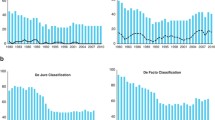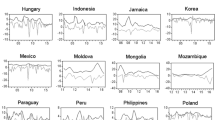Abstract
This study relates to the literature on the exchange rate pass-through effect on inflation for developing economies under inflation targeting. The novelty concerns the investigation of the effect of both monetary and fiscal credibility on pass-through. The article addresses empirical evidence, based on the Brazilian experience, regarding the idea that high credibility might reduce the exchange rate pass-through on inflation. The findings suggest that although monetary credibility is relevant only for pass-through on inflation of market prices, fiscal credibility is an important tool to reduce the pass-through on both inflation and inflation expectations.







Similar content being viewed by others
Notes
For an analysis on the most important lessons on exchange rate policies in emerging countries, see Edwards (2011).
Cecchetti and Krause (2002) also developed a credibility index essentially along the same lines. However, they fix 2 % as inflation target and consider an inflation limit of 20 %. Therefore, this index is not capable of capturing xxx the inflation targeting credibility.
Furthermore, “unlike other countries, net debt includes Central Bank assets and liabilities including, among other items, international reserves (assets) and the monetary base (liabilities)” (Silva et al. 2010, p. 92).
See, for example, Goldfajn and Werlang (2000); Gagnon and Ihrig (2004); Choudhri and Hakura (2006); Correa and Minella (2010); Edwards (2006); Faruqee (2006); McCarthy (2007); Bouakez and Rebei (2008); Nogueira Jr. and Leon Ledesma (2009); Nogueira Jr. (2010); Takhtamanova (2010); Beirne and Bijsterbosch (2011), and An and Wang (2012).
See Table 5 (Appendix) for sources of data and description of the variables.
Administered prices considered in the composition of IPCA are divided into tax, public utility services, and petroleum derivatives.
Taking into account the three tests, at least two indicate that the series under analysis is I(0).
To eliminate any possibility of skewing the results, the maximum of lags applied for each instrument was 6. Furthermore the number of instruments used for all models is lower than 20 (less than 14 % in relation to the number of observations).
References
ABP - Federal Public Debt: Annual Borrowing Plan (2012) National Treasury Secretariat, N. 12, Brasília
An L, Wang J (2012) Exchange rate pass-through: evidence based on vector autoregression with sign restrictions. Open Econ Rev 23(2):359–380
Andersson K, Berg C (1995) “The inflation target in Sweden.” In: Haldane AG (ed.) Targeting inflation. Bank of England, 207–225
Angeletos G (2002) Fiscal policy with non-contingent debt and the optimal maturity structure. Q J Econ 117(2002):1105–1131
Areosa WD, Medeiros M (2007) Inflation dynamics in Brazil: the case of a small open economy. Rev Econometria 27(1):131–166
Ball LM (1999) “Policy rules for open economies,” NBER Chapters, In: Monetary Policy Rules, National Bureau of Economic Research, Inc., 127–156
Batini N, Tereanu E (2010) Inflation targeting during asset and commodity price booms. Oxf Rev Econ Policy 26(1):15–35
Beirne J, Bijsterbosch M (2011) Exchange rate pass-through in central and eastern European EU Member States. J Policy Model 33(2):241–254
Bogdanski J, Tombini AA, Werlang SRC (2000) “Implementing inflation targeting in Brazil” (in) Inflation Targeting in Brazil, Central Bank of Brazil
Bouakez H, Rebei N (2008) Has exchange rate pass-through really declined? Evidence from Canada. J Int Econ 75(2):249–267
Boug P, Cappelen A, Eika T (2013) Exchange rate pass-through in a small open economy: the importance of the distribution sector. Open Econ Rev 24(5):853–879
Calvo G (1988) Servicing the public debt: the role of expectations. Am Econ Rev 78(4):647–661
Calvo G (1997) “Capital flows: emerging issues.” Panel: 3 are we in a Global Economic Crisis, http://www.econ.yale.edu/alumni/reunion99/calvo3.htm
Calvo G, Reinhart CM (2002) Fear of floating. Q J Econ 117(2):379–408
Cecchetti SG, Krause S (2002) “Central bank structure, policy efficiency and macroeconomic performance: exploring empirical relationships.” Review, Federal Reserve Bank of St. Louis 84(4):47–59
Central Bank of Brazil – CBB (2004) “Inflation expectations surveys”. Inflation report
Céspedes LF, Soto C (2005) “Credibility and inflation targeting in an emerging market: the case of Chile.” Central Bank of Chile working paper, 312
Choudhri EU, Hakura DS (2006) Exchange rate pass-through to domestic prices: does the inflationary environment matter? J Int Money Financ 25(4):614–639
Correa AS, Minella A (2010) Nonlinear mechanisms of the exchange rate pass-through: a Phillips curve model with threshold for Brazil. Rev Bras Econ 64(3):231–243
Cristina N, Marilen P, Claudiu B (2011) “Public debt sustainability analysis: Eu case.” Ann of Fac Econ, University of Oradea, Faculty of Economics, 1(1):409–415
Cukierman A, Meltzer AH (1986) A theory of ambiguity, credibility, and inflation under discretion and asymmetric information. Econometrica 54(5):1099–1128
de Mendonça HF (2007) Towards credibility from inflation targeting: the Brazilian experience. Appl Econ 39(19–21):2599–2615
de Mendonça HF, de Guimarães e Souza GJ (2009) Inflation targeting credibility and reputation: the consequences for the interest rate. Econ Model 26(6):1228–1238
de Mendonça HF, Galveas KA (2013) Transparency and inflation: what is the effect on the Brazilian economy? Econ Syst 37(1):69–80
de Mendonça HF, Machado MR (2013) Public debt management and credibility: evidence from an emerging economy. Econ Model 30(1):10–21
de Mendonça HF, Valerio D (2010) What kind of Phillips curve works in the Brazilian inflation targeting? Empir Econ Lett 9(8):803–809
Dieters MAF (2010) “The impact of surprise policy actions on interest rates: the influence of Central Bank Credibility,” Erasmus University Rotterdam
Drudi F, Giordano R (2000) Default risk and optimal debt management. J Bank Financ 24(6):861–891
Edwards S (2006) “The relationship between exchange rates and inflation targeting revisited.” NBER Working Paper, 12163
Edwards S (2011) Exchange-rate policies in emerging countries: eleven empirical regularities from Latin America and East Asia. Open Econ Rev 22(4):533–563
Eichengreen B (2002) “Can emerging markets float? Should they inflation target?” Central Bank of Brazil Working Paper Series, 36
Faraglia E, Marcet A, Scott A (2008) Fiscal insurance and debt management in OECD economies. Econ J 118(527):363–386
Faruqee H (2006) Exchange rate pass-through in the Euro area. IMF Staff Pap 53(1):63–88
Faust J, Svensson LEO (2001) Transparency and Credibility: monetary policy with unobservable goals. Int Econ Rev 42(2):369–397
Fernandes CM (2013) “The credibility of the monetary policy in Brazil: an econometric time series analysis approach.” Universiteit van Amsterdam
Frankel J, Parsley D, Wei S (2012) Slow pass-through around the world: a new import for developing countries? Open Econ Rev 23(2):213–251
Gagnon JE, Ihrig J (2004) Monetary policy and exchange rate pass-through. Int J Financ Econ 9(4):315–338
García CJ, Restrepo JE (2001) “Price inflation and exchange rate pass-through in Chile,” Working Papers Central Bank of Chile 128, Central Bank of Chile
Giannellis N, Koukouritakis M (2013) Exchange rate misalignment and inflation rate persistence: evidence from Latin American countries. Int Rev Econ Financ 25(1):202–218
Giavazzi F, Missale A (2004) “Public debt management in Brazil”, NBER Working Paper 10394
Giavazzi F, Pagano M (1990) Indexation and maturity of government bonds. In: Dornbusch R, Draghi M (eds) Public debt management: theory and history. Cambridge University Press, Cambridge, pp 52–93
Goldfajn I, Olivares G (2001) “Can flexible exchange rates still ‘work’ in financially open economies?,” G-24 Discussion Papers 8, United Nations Conference on Trade and Development
Goldfajn I, Werlang SRC (2000) “The pass-through from depreciation to inflation: a panel study.” Central Bank of Brazil Working Paper Series, 5
Greene WH (1993) Econometric analysis, 5th edn. Prentice Hall, New Jersey
Kanoun S (2014) The sustainability of fiscal adjustment process: a quantitative approach with an application to Tunisia. Asian Econ Financ Rev 4(10):1314–1331
Khemiri R, Ali MSB (2012) “Exchange rate pass-through and inflation dynamics in Tunisia: a Markov-Switching approach,” Economics Discussion Papers 2012-39, Kiel Institute for the World Economy
Koop G, Pesaran MH, Potter SM (1996) Impulse response analysis in non-linear multivariate models. J Econ 74(1):119–147
Lloyd-Ellis H, Zhu X (2001) Fiscal shocks and fiscal risk management. J Monet Econ 48(2):309–338
McCarthy J (2007) Pass-through of exchange rates and import prices to domestic inflation in some industrialized economies. East Econ J 33(4):511–537
Mehl A, Reynaud J (2010) “Risky public domestic debt composition in emerging economies,” J Int Money Financ, Elsevier, 29(1):1–18
Minella A, de Freitas PS, Goldfajn I, Muinhos MK (2003) Inflation targeting in Brazil: constructing credibility under exchange rate volatility. J Int Money Financ 22(7):1015–1040
Mishkin F (2000) Inflation targeting in emerging-market countries. Am Econ Rev 90(2):105–109
Mishkin F, Savastano MA (2001) Monetary policy strategies for Latin America. J Dev Econ 66(2):415–444
Montes GC (2013) Credibility and monetary transmission channels under inflation targeting: an econometric analysis from a developing country. Econ Model 30(C):670–684
Nogueira R Jr (2007) Inflation targeting and exchange rate pass-through. Econ Apl 11(2):189–208
Nogueira R Jr (2010) Inflation environment and lower exchange rate pass-through in Brazil: is there a relationship? Rev Bras Econ 64(1):49–56
Nogueira R Jr, Léon-Ledesma MA (2009) Fear of floating in Brazil: did inflation targeting matter? N Am J Econ Financ 20(3):255–266
Nogueira R Jr, Léon-Ledesma MA (2011) Does exchange rate pass-through respond to measures of macroeconomic instability? J Appl Econ 14(1):167–180
Odria LRM, Castillo P, Rodriguez G (2012) Does the exchange rate pass-through into prices change when inflation targeting is adopted? The Peruvian Case Study between 1994 and 2007. J Macroecon 34(4):1154–1166
Pesaran MH, Shin Y (1998) Generalized impulse response analysis in linear multivariate models. Econ Lett 58(1):17–29
Reyes J (2007) Exchange rate passthrough effects and inflation targeting in emerging economies: what is the relationship? Rev Int Econ 15(3):538–559
Rutkauskas AV, Stasytytė V, Maknickienė N (2014) Government debt as the integral portfolio of assets and liabilities generated by debt. J Bus Econ Manag 15(1):22–40
Salle I, Sénégas MA, Yildizoglu M (2013) “How transparent about its inflation target should a Central Bank be? An Agent-Based Model Assessment.” GREThA Working paper, N. 2013-24, University of Bordeaux
Sargent TJ (1994) “Rational expectations and the reconstruction of macroeconomics.” In: Miller PJ (ed.). The rational expectations revolution: readings from the front line. MIT Press
Schmidt-Hebbel K, Werner A (2002) “inflation targeting in Brazil, Chile, and Mexico: performance, credibility, and the exchange rate.” Central Bank of Chile working paper, 171
Silva AC, Carvalho LO, Medeiros OL (2010) Public debt: the Brazilian experience. National Treasury: World Bank, Brasilia
Sims C (1980) Macroeconomics and reality. Econometrica 48(1):1–48
Svensson LEO (1993) “The simplest test of inflation target credibility.” NBER Working Paper, 4604
Svensson LEO (2000) “How should monetary policy be conducted in an era of price stability?” NBER Working Paper, 7516
Takhtamanova YF (2010) Understanding changes in exchange rate pass-through. J Macroecon 32(4):1118–1130
Taylor J (2000) Low inflation, pass-through, and the pricing power of firms. Eur Econ Rev 44(7):1389–1408
Tombini AA, Alves SAL (2006) “The recent Brazilian disinflation process and costs.” Central Bank of Brazil Working Paper Series, 109
Topalova P, Nyberg D (2010) “What level of public debt could India target?,” IMF Working Papers 10/7, International Monetary Fund
Wooldridge JM (2001) Applications of generalized method of moments estimation. J Econ Perspect 15(4):87–100
Author information
Authors and Affiliations
Corresponding author
Additional information
We thank an anonymous referee for helpful comments on an earlier version of this paper. Any remaining errors are the sole responsibility of the authors.
Appendix
Appendix
Rights and permissions
About this article
Cite this article
de Mendonça, H.F., Tostes, F.S. The Effect of Monetary and Fiscal Credibility on Exchange Rate Pass-Through in an Emerging Economy. Open Econ Rev 26, 787–816 (2015). https://doi.org/10.1007/s11079-014-9339-3
Published:
Issue Date:
DOI: https://doi.org/10.1007/s11079-014-9339-3





